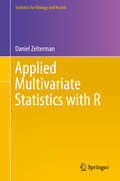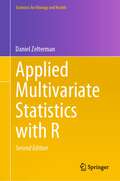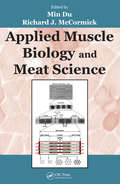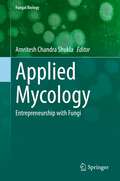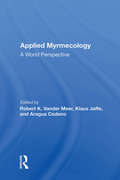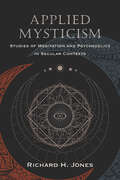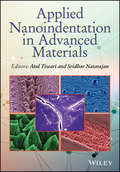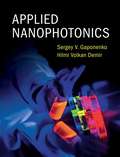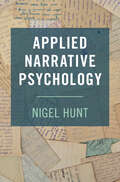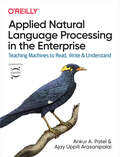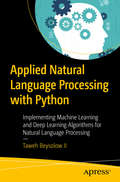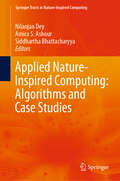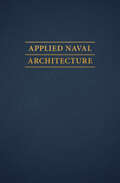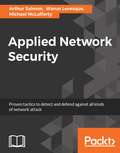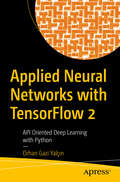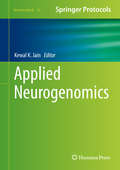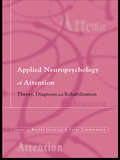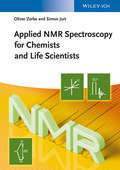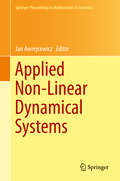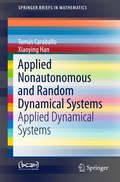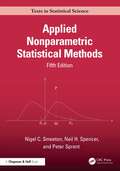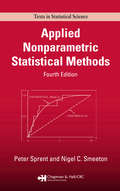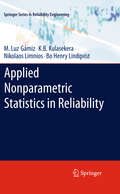- Table View
- List View
Applied Multivariate Statistics with R (Statistics for Biology and Health)
by Daniel ZeltermanThis book brings the power of multivariate statistics to graduate-level practitioners, making these analytical methods accessible without lengthy mathematical derivations. Using the open source, shareware program R, Professor Zelterman demonstrates the process and outcomes for a wide array of multivariate statistical applications. Chapters cover graphical displays, linear algebra, univariate, bivariate and multivariate normal distributions, factor methods, linear regression, discrimination and classification, clustering, time series models, and additional methods. Zelterman uses practical examples from diverse disciplines to welcome readers from a variety of academic specialties. Those with backgrounds in statistics will learn new methods while they review more familiar topics. Chapters include exercises, real data sets, and R implementations. The data are interesting, real-world topics, particularly from health and biology-related contexts. As an example of the approach, the text examines a sample from the Behavior Risk Factor Surveillance System, discussing both the shortcomings of the data as well as useful analyses. The text avoids theoretical derivations beyond those needed to fully appreciate the methods. Prior experience with R is not necessary.
Applied Multivariate Statistics with R
by Daniel ZeltermanNow in its second edition, this book brings multivariate statistics to graduate-level practitioners, making these analytical methods accessible without lengthy mathematical derivations. Using the open source shareware program R, Dr. Zelterman demonstrates the process and outcomes for a wide array of multivariate statistical applications. Chapters cover graphical displays; linear algebra; univariate, bivariate and multivariate normal distributions; factor methods; linear regression; discrimination and classification; clustering; time series models; and additional methods. He uses practical examples from diverse disciplines, to welcome readers from a variety of academic specialties. Each chapter includes exercises, real data sets, and R implementations. The book avoids theoretical derivations beyond those needed to fully appreciate the methods. Prior experience with R is not necessary. <p><p> New to this edition are chapters devoted to longitudinal studies and the clustering of large data. It is an excellent resource for students of multivariate statistics, as well as practitioners in the health and life sciences who are looking to integrate statistics into their work.
Applied Multivariate Statistics with R (Statistics for Biology and Health)
by Daniel ZeltermanNow in its second edition, this book brings multivariate statistics to graduate-level practitioners, making these analytical methods accessible without lengthy mathematical derivations. Using the open source shareware program R, Dr. Zelterman demonstrates the process and outcomes for a wide array of multivariate statistical applications. Chapters cover graphical displays; linear algebra; univariate, bivariate and multivariate normal distributions; factor methods; linear regression; discrimination and classification; clustering; time series models; and additional methods. He uses practical examples from diverse disciplines, to welcome readers from a variety of academic specialties. Each chapter includes exercises, real data sets, and R implementations. The book avoids theoretical derivations beyond those needed to fully appreciate the methods. Prior experience with R is not necessary.New to this edition are chapters devoted to longitudinal studies and the clustering of large data. It is an excellent resource for students of multivariate statistics, as well as practitioners in the health and life sciences who are looking to integrate statistics into their work.
Applied Muscle Biology and Meat Science
by Richard J. McCormick Min DuKnowledge of muscle biology is continuing to expand in the animal and food sciences industry, especially the understanding of the mechanisms that control skeletal muscle development, growth, and their impacts on meat production and quality. Applied Muscle Biology and Meat Science provides agriculturalists with state-of-the-art information and a platform to further explore this specialized topic. It also gives novices a comprehensive knowledge base in applied muscle biology and meat science. Many existing problems in meat science and production are due to a lack of understanding of the underlying biological mechanisms of the livestock. Careful to avoid gory processing details, the text focuses on biological changes and the appropriate manage
Applied Mycology: Entrepreneurship with Fungi (Fungal Biology)
by Amritesh Chandra ShuklaFungi are an important link in the food webs of all ecosystems. They have immense potential and comprise a myriad of useful bioactive compounds. Fungi feature in a wide range of diverse processes and applications in modern agriculture, the food science industry, and the pharmaceutical industry. In the food and drink arena, the role of fungi is historically important in the form of mushrooms and in fermented foods as yeasts for baking and brewing. These roles are supplemented by the use of fungal food processing enzymes and additives, and more recently in the development of protein-based foodstuffs from fungi. Additionally, they are used in the formulation of biofertilizers and biopesticides used as biostimulants and bioprotectants of crops. The practical use of newer techniques such as genetic recombination and robotics have revolutionized the modem agricultural biotechnology industry, and have created an enormous range of possible further applications of fungal products.Myco-materials created from mycelia (the root-like parts of fungi) are gaining attention as a sustainable alternative for a wide range of materials. They are being used as insulation, sustainable packaging, foam inserts, and even "eco-leather.” In fact, mycelium bricks are pound-for-pound stronger than concrete. In addition, medicinal uses of fungal species have been historically recorded as important agents in the pharmaceutical sciences. The potential for myco-materials seems limitless. The field of mycology and its application has become an increasingly important component in the education of industrial biotechnology. This book on applied mycology provides information helpful for developing entrepreneurial opportunities with fungi. This volume explains both the basic science and the applications of mycology and bio-resource technology with special emphasis on entrepreneurial applications. It offers a complete, one-stop resource for those interested in microbiology, food and agricultural science, medical mycology, and for those in industrial biotechnology.
Applied Myrmecology: A World Perspective (Westview Studies In Insect Biology)
by Robert K Vander MeerAnts have always fascinated the nature observer. Reports from ancient Egypt and Mesopotamia indicate that ants interested humans long ago. Myrmecology as a science had its beginning in the last century with great naturalists like Andre, Darwin, Emery, Escherich, Fabre, Fields, Forel, Janet, Karawaiew, McCook, Mayr, Smith, Wasmann and Wheeler. They studied ants as an interesting biological phenomenon, with little thought of the possible beneficial or detrimental effects ants could have on human activities (see Wheeler 1910 as an example). When Europeans began colonizing the New World, serious ant problems occurred. The first reports of pest ants came from Spanish and Portuguese officials of the fifteenth and sixteenth centuries in Trinidad, The West Indies, Central America and South America. Leaf-cutting ants were blamed for making agricultural development almost impossible in many areas. These ants, Atta and Acromyrmex species, are undoubtedly the first ants identified as pests and may be considered to have initiated interest and research in applied myrmecology (Mariconi 1970).
Applied Mysticism: Studies of Meditation and Psychedelics in Secular Contexts
by Richard H. JonesExamines how mystical practices and experiences are being applied in secular contexts today.Today is an exciting time for mysticism. Interest in mysticism today often involves what Aldous Huxley called "applied mysticism"-that is, taking mystical practices and experiences out of their traditional contexts, where the focus was on the total transformation of the individual, and applying them (often within a secular framework) to help other people with more limited this-worldly problems, such as a person's well-being in society or general social change. Neuroscientists are taking mystical experiences seriously, studying meditators and psychedelic subjects to gain knowledge of how the brain works. Cognitive scientists are exploring mystical altered states of consciousness to expand the spectrum of consciousness states-in particular, whether there is a state of "pure" consciousness. Buddhist meditation is being taken out of its religious contexts and adapted by psychotherapists to help with problems such as depression or addiction. The use of psychedelics in psychotherapy is also gaining traction while New Age thinkers are extolling the alleged merger of post-Newtonian science with mysticism. Mystical ideas are being adapted to problems on the social level-for example, in "socially-engaged" Buddhism. This is the first book to explore all these varieties of applied mysticism together and to examine the current state of the field (with a focus on philosophical issues) in a readily accessible manner.
Applied Nanoindentation in Advanced Materials
by Atul Tiwari Sridhar NatarajanResearch in the area of nanoindentation has gained significant momentum in recent years, but there are very few books currently available which can educate researchers on the application aspects of this technique in various areas of materials science. Applied Nanoindentation in Advanced Materials addresses this need and is a comprehensive, self-contained reference covering applied aspects of nanoindentation in advanced materials. With contributions from leading researchers in the field, this book is divided into three parts. Part one covers innovations and analysis, and parts two and three examine the application and evaluation of soft and ceramic-like materials respectively. Key features: A one stop solution for scholars and researchers to learn applied aspects of nanoindentation Contains contributions from leading researchers in the field Includes the analysis of key properties that can be studied using the nanoindentation technique Covers recent innovations Includes worked examples Applied Nanoindentation in Advanced Materials is an ideal reference for researchers and practitioners working in the areas of nanotechnology and nanomechanics, and is also a useful source of information for graduate students in mechanical and materials engineering, and chemistry. This book also contains a wealth of information for scientists and engineers interested in mathematical modelling and simulations related to nanoindentation testing and analysis.
Applied Nanophotonics
by Sergey V. Gaponenko Hilmi Volkan DemirWith full color throughout, this unique text provides an accessible yet rigorous introduction to the basic principles, technology, and applications of nanophotonics. It explains key physical concepts such as quantum confinement in semiconductors, light confinement in metal and dielectric nanostructures, and wave coupling in nanostructures, and describes how they can be applied in lighting sources, lasers, photonic circuitry, and photovoltaic systems. Readers will gain an intuitive insight into the commercial implementation of nanophotonic components, in both current and potential future devices, as well as challenges facing the field. The fundamentals of semiconductor optics, optical material properties, and light propagation are included, and new and emerging fields such as colloidal photonics, Si-based photonics, nanoplasmonics, and bioinspired photonics are all discussed. This is the 'go-to' guide for graduate students and researchers in electrical engineering who are interested in nanophotonics, and students taking nanophotonics courses.
Applied Natural Language Processing in the Enterprise
by Ankur A. Patel Ajay Uppili ArasanipalaiNLP has exploded in popularity over the last few years. But while Google, Facebook, OpenAI, and others continue to release larger language models, many teams still struggle with building NLP applications that live up to the hype. This hands-on guide helps you get up to speed on the latest and most promising trends in NLP.With a basic understanding of machine learning and some Python experience, you'll learn how to build, train, and deploy models for real-world applications in your organization. Authors Ankur Patel and Ajay Uppili Arasanipalai guide you through the process using code and examples that highlight the best practices in modern NLP.Use state-of-the-art NLP models such as BERT and GPT-3 to solve NLP tasks such as named entity recognition, text classification, semantic search, and reading comprehensionTrain NLP models with performance comparable or superior to that of out-of-the-box systemsLearn about Transformer architecture and modern tricks like transfer learning that have taken the NLP world by stormBecome familiar with the tools of the trade, including spaCy, Hugging Face, and fast.aiBuild core parts of the NLP pipeline--including tokenizers, embeddings, and language models--from scratch using Python and PyTorchTake your models out of Jupyter notebooks and learn how to deploy, monitor, and maintain them in production
Applied Natural Language Processing with Python: Implementing Machine Learning And Deep Learning Algorithms For Natural Language Processing
by Taweh Beysolow IILearn to harness the power of AI for natural language processing, performing tasks such as spell check, text summarization, document classification, and natural language generation. Along the way, you will learn the skills to implement these methods in larger infrastructures to replace existing code or create new algorithms. Applied Natural Language Processing with Python starts with reviewing the necessary machine learning concepts before moving onto discussing various NLP problems. After reading this book, you will have the skills to apply these concepts in your own professional environment.What You Will Learn Utilize various machine learning and natural language processing libraries such as TensorFlow, Keras, NLTK, and GensimManipulate and preprocess raw text data in formats such as .txt and .pdfStrengthen your skills in data science by learning both the theory and the application of various algorithms Who This Book Is For You should be at least a beginner in ML to get the most out of this text, but you needn’t feel that you need be an expert to understand the content.
Applied Nature-Inspired Computing: Algorithms and Case Studies (Springer Tracts in Nature-Inspired Computing)
by Nilanjan Dey Amira S. Ashour Siddhartha BhattacharyyaThis book presents a cutting-edge research procedure in the Nature-Inspired Computing (NIC) domain and its connections with computational intelligence areas in real-world engineering applications. It introduces readers to a broad range of algorithms, such as genetic algorithms, particle swarm optimization, the firefly algorithm, flower pollination algorithm, collision-based optimization algorithm, bat algorithm, ant colony optimization, and multi-agent systems. In turn, it provides an overview of meta-heuristic algorithms, comparing the advantages and disadvantages of each. Moreover, the book provides a brief outline of the integration of nature-inspired computing techniques and various computational intelligence paradigms, and highlights nature-inspired computing techniques in a range of applications, including: evolutionary robotics, sports training planning, assessment of water distribution systems, flood simulation and forecasting, traffic control, gene expression analysis, antenna array design, and scheduling/dynamic resource management.
Applied Naval Architecture
by Robert B ZubalyApplied Naval Architecture is intended for undergraduate students of many of the disciplines in maritime affairs, including marine engineering, marine transportation, nautical science, shipbuilding or ship production (shipyard apprentice schools), marine electrical engineering, meteorology, and oceanography. It could be used as an introduction to naval architecture for technical personnel of all types already employed in shipyards, for licensed officers as a general reference, and preparation for license upgrading examinations. It describes in detail what naval architects do, and how they do it, to all students and practitioners involved in the business of merchant ships and shipping, except for professional naval architects themselves. Students preparing for a degree in naval architecture would find the book useful as an introduction to their profession.
Applied Network Security
by Arthur Salmon Michael MclaffertyThis book is for network security professionals, cyber security professionals, and Pentesters who are well versed with fundamentals of network security and now want to master it. So whether you’re a cyber security professional, hobbyist, business manager, or student aspiring to becoming an ethical hacker or just want to learn more about the cyber security aspect of the IT industry, then this book is definitely for you.
Applied Neural Networks with TensorFlow 2: API Oriented Deep Learning with Python
by Orhan Gazi YalçınImplement deep learning applications using TensorFlow while learning the “why” through in-depth conceptual explanations. You’ll start by learning what deep learning offers over other machine learning models. Then familiarize yourself with several technologies used to create deep learning models. While some of these technologies are complementary, such as Pandas, Scikit-Learn, and Numpy—others are competitors, such as PyTorch, Caffe, and Theano. This book clarifies the positions of deep learning and Tensorflow among their peers. You'll then work on supervised deep learning models to gain applied experience with the technology. A single-layer of multiple perceptrons will be used to build a shallow neural network before turning it into a deep neural network. After showing the structure of the ANNs, a real-life application will be created with Tensorflow 2.0 Keras API. Next, you’ll work on data augmentation and batch normalization methods. Then, the Fashion MNIST dataset will be used to train a CNN. CIFAR10 and Imagenet pre-trained models will be loaded to create already advanced CNNs. Finally, move into theoretical applications and unsupervised learning with auto-encoders and reinforcement learning with tf-agent models. With this book, you’ll delve into applied deep learning practical functions and build a wealth of knowledge about how to use TensorFlow effectively. What You'll Learn Compare competing technologies and see why TensorFlow is more popularGenerate text, image, or sound with GANsPredict the rating or preference a user will give to an itemSequence data with recurrent neural networks Who This Book Is For Data scientists and programmers new to the fields of deep learning and machine learning APIs.
Applied Neurogenomics (Neuromethods #97)
by Kewal K. JainThis detailed volume reflects the considerable new developments that have taken place in the area of applied neurogenomics, particularly with the rapid progress in next generation sequencing. Beginning with an introduction to the technologies relevant to neurogenomics with an emphasis on next generation sequencing, the book also covers detailed methods relevant to the genomics of neurodegenerative diseases, particularly Alzheimer's disease and Huntington's disease, targeted sequencing of psychiatric disorders, as well as the role of genomics in the development of personalized neurology. Written in the popular Neuromethods series format, chapters provide the kind of practical description and implementation advice necessary to consistently produce successful results in the lab. Timely and convenient, Applied Neurogenomics serves as an invaluable reference for researchers working in this expanding, dynamic field.
Applied Neuropsychology of Attention: Theory, Diagnosis and Rehabilitation
by Michel Leclercq Peter ZimmermannThe concept of attention in academic psychology has been treated with varying degrees of importance over the years. From playing a key role in the 19th century, it was discarded in the first half of the 20th century, as clinical psychologists claimed it was superfluous to the essential subconscious processes of the mind, and experimental psychologists thought it was not a scientific term. Applied Neuropsychology of Attention aims to review the considerable developments in the field of attention over the last 20 years as it makes its comeback.This collection of essays forms a comprehensive overview of this crucial component of human cognitive function. The book begins with an explanation of the essential theoretical concepts and definitions. Aspects of diagnosis are then discussed as the assessment and impairments of attention are reviewed in normal ageing and in specific neurological categories. Victims of brain injury and patients with cerebrovascular or neurodegenerative diseases are considered. A critical analysis of existing practices in cognitive rehabilitation is given and a review of the techniques and methodologies used for treating attentional disturbances brings the book to a conclusion.Leclercq and Zimmermann have compiled a book of cutting-edge research which provides an effective framework to detect, analyse and understand the nature of attention deficit. The book will be invaluable to clinicians, mental health specialists and all academic psychologists in the field.
Applied NMR Spectroscopy for Chemists and Life Scientists
by Oliver Zerbe Simon JurtFrom complex structure elucidation to biomolecular interactions - this applicationoriented textbook covers both theory and practice of modern NMR applications.Part one sets the stage with a general description of NMR introducing important parameters such as the chemical shift and scalar or dipolar couplings. Part two describes the theory behind NMR, providing a profound understanding of the involved spin physics, deliberately kept shorter than in other NMR textbooks, and without a rigorous mathematical treatment of all the physico-chemical computations. Part three discusses technical and practical aspects of how to use NMR. Important phenomena such as relaxation, exchange, or the nuclear Overhauser effects and the methods of modern NMR spectroscopy including multidimensional experiments, solid state NMR, and the measurement of molecular interactions are the subject of part four. The final part explains the use of NMR for the structure determination of selected classes of complex biomolecules, from steroids to peptides or proteins, nucleic acids, and carbohydrates.For chemists as well as users of NMR technology in the biological sciences.
Applied Non-Linear Dynamical Systems (Springer Proceedings in Mathematics & Statistics #93)
by Jan AwrejcewiczThe book is a collection of contributions devoted to analytical, numerical and experimental techniques of dynamical systems, presented at the International Conference on Dynamical Systems: Theory and Applications, held in Å ódź, Poland on December 2-5, 2013. The studies give deep insight into both the theory and applications of non-linear dynamical systems, emphasizing directions for future research. Topics covered include: constrained motion of mechanical systems and tracking control; diversities in the inverse dynamics; singularly perturbed ODEs with periodic coefficients; asymptotic solutions to the problem of vortex structure around a cylinder; investigation of the regular and chaotic dynamics; rare phenomena and chaos in power converters; non-holonomic constraints in wheeled robots; exotic bifurcations in non-smooth systems; micro-chaos; energy exchange of coupled oscillators; HIV dynamics; homogenous transformations with applications to off-shore slender structures; novel approaches to a qualitative study of a dissipative system; chaos of postural sway in humans; oscillators with fractional derivatives; controlling chaos via bifurcation diagrams; theories relating to optical choppers with rotating wheels; dynamics in expert systems; shooting methods for non-standard boundary value problems; automatic sleep scoring governed by delay differential equations; isochronous oscillations; the aerodynamics pendulum and its limit cycles; constrained N-body problems; nano-fractal oscillators and dynamically-coupled dry friction.
Applied Nonautonomous and Random Dynamical Systems: Applied Dynamical Systems (SpringerBriefs in Mathematics)
by Tomás Caraballo Xiaoying HanThis book offers an introduction to the theory of non-autonomous and stochastic dynamical systems, with a focus on the importance of the theory in the Applied Sciences. It starts by discussing the basic concepts from the theory of autonomous dynamical systems, which are easier to understand and can be used as the motivation for the non-autonomous and stochastic situations. The book subsequently establishes a framework for non-autonomous dynamical systems, and in particular describes the various approaches currently available for analysing the long-term behaviour of non-autonomous problems. Here, the major focus is on the novel theory of pullback attractors, which is still under development. In turn, the third part represents the main body of the book, introducing the theory of random dynamical systems and random attractors and revealing how it may be a suitable candidate for handling realistic models with stochasticity. A discussion of future research directions serves to round out the coverage.
Applied Nonparametric Econometrics
by Daniel J. Henderson Christopher F. ParmeterThe majority of empirical research in economics ignores the potential benefits of nonparametric methods, while the majority of advances in nonparametric theory ignores the problems faced in applied econometrics. This book helps bridge this gap between applied economists and theoretical nonparametric econometricians. It discusses in depth, and in terms that someone with only one year of graduate econometrics can understand, basic to advanced nonparametric methods. The analysis starts with density estimation and motivates the procedures through methods that should be familiar to the reader. It then moves on to kernel regression, estimation with discrete data, and advanced methods such as estimation with panel data and instrumental variables models. The book pays close attention to the issues that arise with programming, computing speed, and application. In each chapter, the methods discussed are applied to actual data, paying attention to presentation of results and potential pitfalls.
Applied Nonparametric Statistical Methods (Chapman & Hall/CRC Texts in Statistical Science)
by null Nigel Smeeton null Neil Spencer null Peter SprentNonparametric statistical methods minimize the number of assumptions that need to be made about the distribution of data being analysed, unlike classical parametric methods. As such, they are an essential part of a statistician’s armoury, and this book is an essential resource in their application. Starting from the basics of statistics, it takes the reader through the main nonparametric approaches with an emphasis on carefully explained examples backed up by use of the R programming language.Key features of this fully revised and extended fifth edition include the following: An introductory chapter that provides a gentle introduction to the basics of statistics, including types of data, hypothesis testing, confidence intervals and ethical issues An R package containing functions that have been written for the examples in the text and the exercises Summary bullet points at the end of each section to enable the reader to locate important principles quickly A case study from medical research to demonstrate nonparametric approaches to the data analysis Examples fully integrated into the text, drawn from published research on contemporary issues, with more detail given in their explanation Extensive exercises along with complete solutions that allow the reader to test their understanding of the material Articles used in the examples and exercises carefully chosen to enable readers to identify up-to-date literature in their field for research, publications and teaching material Numerous historical references throughout the text, from which to explore the origins of nonparametric methods Applied Nonparametric Statistical Methods, Fifth Edition, is a comprehensive course text in nonparametric techniques suitable for undergraduate students of mathematics and statistics. It assumes only basic previous experience of statistics, and with algebra kept to a minimum, it is also ideal for quantitative methods modules delivered to undergraduate or postgraduate students in science, business and health service training. It is an invaluable resource for researchers, medical practitioners, business managers, research and development staff, and others needing to interpret quantitative information. Suitable for self-directed learning in continuing professional development, it also acts as a handy accessible reference manual.
Applied Nonparametric Statistical Methods (Chapman & Hall/CRC Texts in Statistical Science)
by Peter Sprent Nigel C. SmeetonWhile preserving the clear, accessible style of previous editions, Applied Nonparametric Statistical Methods, Fourth Edition reflects the latest developments in computer-intensive methods that deal with intractable analytical problems and unwieldy data sets. Reorganized and with additional material, this edition begins with a brief summary of some
Applied Nonparametric Statistics in Reliability (Springer Series in Reliability Engineering)
by Nikolaos Limnios M. Luz Gámiz Bo Henry Lindqvist K. B. KulasekeraNonparametric statistics has probably become the leading methodology for researchers performing data analysis. It is nevertheless true that, whereas these methods have already proved highly effective in other applied areas of knowledge such as biostatistics or social sciences, nonparametric analyses in reliability currently form an interesting area of study that has not yet been fully explored. Applied Nonparametric Statistics in Reliability is focused on the use of modern statistical methods for the estimation of dependability measures of reliability systems that operate under different conditions. The scope of the book includes: smooth estimation of the reliability function and hazard rate of non-repairable systems; study of stochastic processes for modelling the time evolution of systems when imperfect repairs are performed; nonparametric analysis of discrete and continuous time semi-Markov processes; isotonic regression analysis of the structure function of a reliability system, and lifetime regression analysis. Besides the explanation of the mathematical background, several numerical computations or simulations are presented as illustrative examples. The corresponding computer-based methods have been implemented using R and MATLAB®. A concrete modelling scheme is chosen for each practical situation and, in consequence, a nonparametric inference procedure is conducted. Applied Nonparametric Statistics in Reliability will serve the practical needs of scientists (statisticians and engineers) working on applied reliability subjects.
